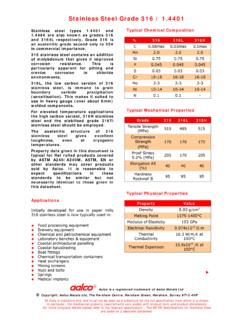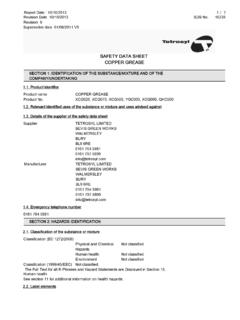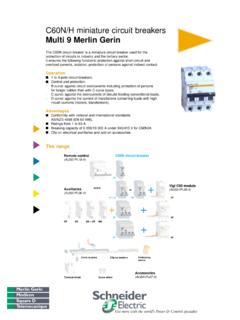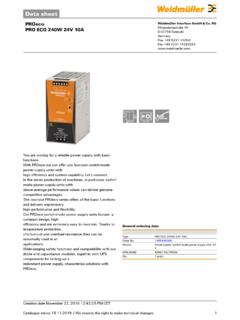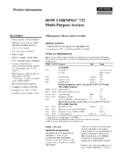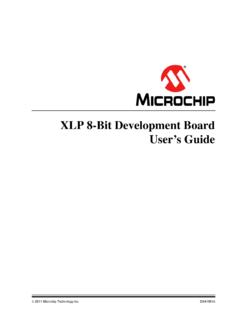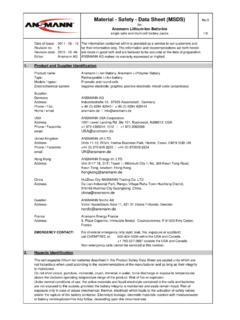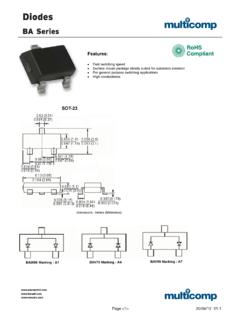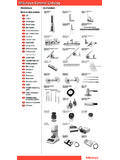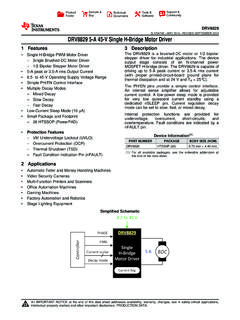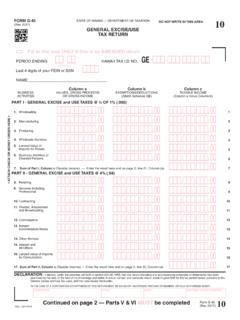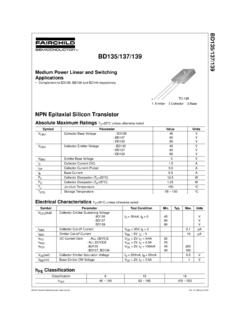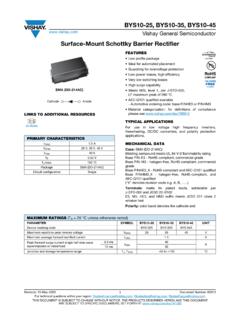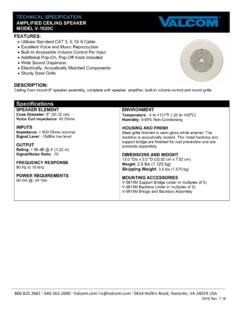Transcription of Atmel 8-bit AVR Microcontroller with 2/4/8K Bytes In ...
1 2586O AVR 02/13 Features High Performance, Low Power AVR 8-bit Microcontroller Advanced RISC Architecture 120 Powerful Instructions Most Single Clock Cycle Execution 32 x 8 General Purpose Working Registers Fully Static Operation Non-volatile Program and Data Memories 2/4/8K Bytes of In-System Programmable Program Memory Flash Endurance: 10,000 Write/Erase Cycles 128/256/512 Bytes In-System Programmable EEPROM Endurance: 100,000 Write/Erase Cycles 128/256/512 Bytes Internal SRAM Programming Lock for Self-Programming Flash Program and EEPROM Data Security Peripheral Features 8-bit Timer/Counter with Prescaler and Two PWM Channels 8-bit High Speed Timer/Counter with Separate Prescaler 2 High Frequency PWM Outputs with Separate Output Compare Registers Programmable Dead Time Generator USI Universal Serial Interface with Start Condition Detector 10-bit ADC 4 Single Ended Channels 2 Differential ADC Channel
2 Pairs with Programmable Gain (1x, 20x) Temperature Measurement Programmable Watchdog Timer with Separate On-chip Oscillator On-chip Analog Comparator Special Microcontroller Features debugWIRE On-chip Debug System In-System Programmable via SPI Port External and Internal Interrupt Sources Low Power Idle, ADC Noise Reduction, and Power-down Modes Enhanced Power-on Reset Circuit Programmable Brown-out Detection Circuit Internal Calibrated Oscillator I/O and Packages Six Programmable I/O Lines 8-pin PDIP, 8-pin SOIC.
3 20-pad QFN/MLF, and 8-pin TSSOP (only ATtiny45/V) Operating Voltage - for ATtiny25V/45V/85V - for ATtiny25/45/85 Speed Grade ATtiny25V/45V/85V: 0 4 MHz @ - , 0 - 10 MHz @ - ATtiny25/45/85: 0 10 MHz @ - , 0 - 20 MHz @ - Industrial Temperature Range Low Power Consumption Active Mode: 1 MHz, : 300 A Power-down Mode: A at 8-bit AVR Microcontroller with 2/4/8K Bytes In-System Programmable FlashATtiny25/V / ATtiny45/V / ATtiny85/VRev. 2586O AVR 02/132 ATtiny25/45/85 [DATASHEET]2586O AVR 02/131.
4 Pin ConfigurationsFigure ATtiny25/45 B (PB5:PB0)Port B is a 6-bit bi-directional I/O port with internal pull-up resistors (selected for each bit). The Port B output buffershave symmetrical drive characteristics with both high sink and source capability. As inputs, Port B pins that areexternally pulled low will source current if the pull-up resistors are activated. The Port B pins are tri-stated when areset condition becomes active, even if the clock is not (PCINT5/RESET/ADC0/dW) PB5(PCINT3/XTAL1/CLKI/OC1B/ADC3) PB3(PCINT4/XTAL2/CLKO/OC1B/ADC2) PB4 GNDVCCPB2 (SCK/USCK/SCL/ADC1/T0/INT0/PCINT2)PB1 (MISO/DO/AIN1/OC0B/OC1A/PCINT1)PB0 (MOSI/DI/SDA/AIN0/OC0A/OC1A/AREF/PCINT0) PDIP/SOIC/TSSOP12345 QFN/MLF15141312112019181716678910 DNCDNCGNDDNCDNCDNCDNCDNCDNCDNCNOTE: Bottom pad should be soldered to : Do Not ConnectNOTE.
5 TSSOP only for ATtiny45/V(PCINT5/RESET/ADC0/dW) PB5(PCINT3/XTAL1/CLKI/OC1B/ADC3) PB3 DNCDNC(PCINT4/XTAL2/CLKO/OC1B/ADC2) PB4 VCCPB2 (SCK/USCK/SCL/ADC1/T0/INT0/PCINT2)DNCPB1 (MISO/DO/AIN1/OC0B/OC1A/PCINT1)PB0 (MOSI/DI/SDA/AIN0/OC0A/OC1A/AREF/PCINT0) 3 ATtiny25/45/85 [DATASHEET]2586O AVR 02/13 Port B also serves the functions of various special features of the ATtiny25/45/85 as listed in Alternate Functionsof Port B on page ATtiny25, the programmable I/O ports PB3 and PB4 (pins 2 and 3) are exchanged in ATtiny15 CompatibilityMode for supporting the backward compatibility with input.
6 A low level on this pin for longer than the minimum pulse length will generate a reset, even if the clockis not running and provided the reset pin has not been disabled. The minimum pulse length is given in Table 21-4on page 164. Shorter pulses are not guaranteed to generate a reset pin can also be used as a (weak) I/O [DATASHEET]2586O AVR 02/132. OverviewThe ATtiny25/45/85 is a low-power CMOS 8-bit Microcontroller based on the AVR enhanced RISC architecture. Byexecuting powerful instructions in a single clock cycle, the ATtiny25/45/85 achieves throughputs approaching 1 MIPS per MHz allowing the system designer to optimize power consumption versus processing DiagramFigure DiagramThe AVR core combines a rich instruction set with 32 general purpose working registers.
7 All 32 registers aredirectly connected to the Arithmetic Logic Unit (ALU), allowing two independent registers to be accessed in onesingle instruction executed in one clock cycle. The resulting architecture is more code efficient while achievingthroughputs up to ten times faster than conventional CISC CONTROLREGISTERGENERALPURPOSEREGISTERSIN STRUCTIONREGISTERTIMER/COUNTER0 SERIALUNIVERSALINTERFACETIMER/COUNTER1 INSTRUCTIONDECODERDATA BDATA REGISTERPORT BPROGRAMMINGLOGICTIMING ANDCONTROLMCU STATUSREGISTERSTATUSREGISTERALUPORT B DRIVERSPB[0.]
8 5]VCCGNDCONTROLLINES8-BIT DATABUSZADC / ANALOG COMPARATORINTERRUPTUNITDATAEEPROMOSCILLA TORSYXRESET5 ATtiny25/45/85 [DATASHEET]2586O AVR 02/13 The ATtiny25/45/85 provides the following features: 2/4/8K Bytes of In-System Programmable Flash, 128/256/512bytes EEPROM, 128/256/256 Bytes SRAM, 6 general purpose I/O lines, 32 general purpose working registers, one8-bit Timer/Counter with compare modes, one 8-bit high speed Timer/Counter, Universal Serial Interface, Internaland External Interrupts, a 4-channel, 10-bit ADC, a programmable Watchdog Timer with internal Oscillator, andthree software selectable power saving modes.
9 Idle mode stops the CPU while allowing the SRAM, Timer/Counter,ADC, Analog Comparator, and Interrupt system to continue functioning. Power-down mode saves the register con-tents, disabling all chip functions until the next Interrupt or Hardware Reset. ADC Noise Reduction mode stops theCPU and all I/O modules except ADC, to minimize switching noise during ADC device is manufactured using Atmel s high density non-volatile memory technology. The On-chip ISP Flashallows the Program memory to be re-programmed In-System through an SPI serial interface, by a conventionalnon-volatile memory programmer or by an On-chip boot code running on the AVR ATtiny25/45/85 AVR is supported with a full suite of program and system development tools including: C Com-pilers, Macro Assemblers, Program Debugger/Simulators and Evaluation [DATASHEET]2586O AVR 02/133.
10 Comprehensive set of development tools, application notes and datasheets are available for download ExamplesThis documentation contains simple code examples that briefly show how to use various parts of the device. Thesecode examples assume that the part specific header file is included before compilation. Be aware that not all Ccompiler vendors include bit definitions in the header files and interrupt handling in C is compiler confirm with the C compiler documentation for more I/O Registers located in the extended I/O map, IN , OUT , SBIS , SBIC , CBI , and SBI instructions mustbe replaced with instructions that allow access to extended I/O.
